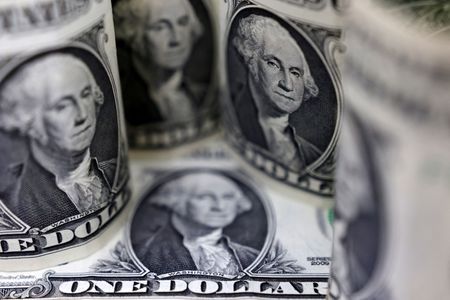By Rae Wee
SINGAPORE (Reuters) -The dollar was broadly weaker on Wednesday after a modest but short-lived boost following better-than-expected U.S. retail sales data, as traders focused on the prospect of Federal Reserve rate cuts as early as September.
The New Zealand dollar rose as data showed domestically driven inflation remained high in the second quarter, even as the headline figure missed expectations.
The kiwi gained 0.35% to $0.6071, though futures showed markets are sticking to bets of about three rate cuts from the Reserve Bank of New Zealand (RBNZ) this year.
“Today’s CPI release confirms that inflation is all but certain to return to the RBNZ’s 1-3% target by Q3,” said Abhijit Surya, Australia and New Zealand economist at Capital Economics.
“In the context of an extremely weak economy and a rapidly loosening labour market, there is a growing chance that the bank will start easing policy at its next meeting in August.”
In the broader market, the dollar was on the back foot, failing to sustain gains after Tuesday’s U.S. retail sales data, which pointed to consumer resilience in the world’s largest economy and bolstered economic growth prospects for the second quarter.
Against the greenback, the euro rose 0.06% to $1.0906, while the Australian dollar edged 0.1% higher to $0.6740.
The dollar index ticked marginally lower to 104.19.
“Ultimately, the story that I think best describes it is that the markets have chosen the story of a Goldilocks economy,” said Kyle Rodda, senior financial market analyst at Capital.com.
“Yes, retail sales are solid, at least on a nominal basis, and consumer demand is strong. But the more important data is the inflation data, and that’s telling the market that the Fed is in a position to cut fairly soon.”
Investors have fully priced in a rate cut from the Fed come September, and are expecting more than 60 basis points worth of easing by the year end.
Elsewhere, sterling was little changed at $1.2972, ahead of UK inflation data due later on Wednesday.
Consumer prices are expected to have cooled further in June, which could add to the case for an imminent easing cycle from the Bank of England.
“We expect June’s UK inflation report to further cement expectations of an interest rate cut at the Bank of England’s August meeting,” said Henk Potts, market strategist at Barclays Private Bank.
“We project that the headline consumer price index could continue to ease hitting 1.9% (year-on-year), driven by disinflationary pressures in both core goods and services.”
The yen was last steady at 158.34 per dollar, as traders remained on alert for any intervention from Japanese authorities to prop up the currency after they had likely done so last week.
Bank of Japan data released on Tuesday suggested Tokyo may have spent 2.14 trillion yen ($13.5 billion) intervening on Friday last week. Combined with the estimated amount spent on Thursday, Japan is suspected to have bought nearly 6 trillion yen via intervention last week.
(Reporting by Rae Wee. Editing by Sam Holmes)





